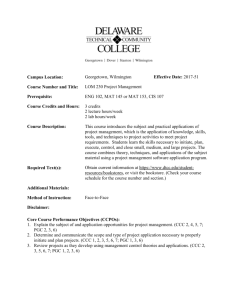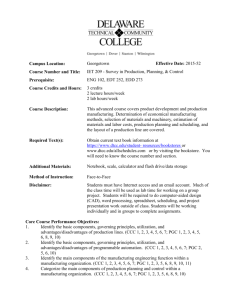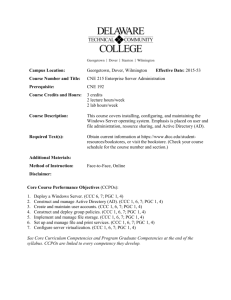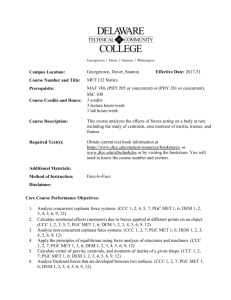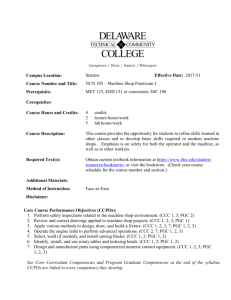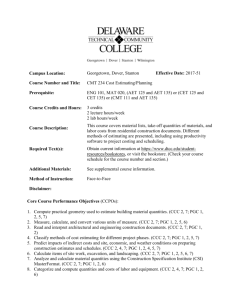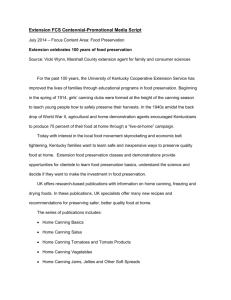Campus Location: Georgetown Effective Date: 2017
advertisement
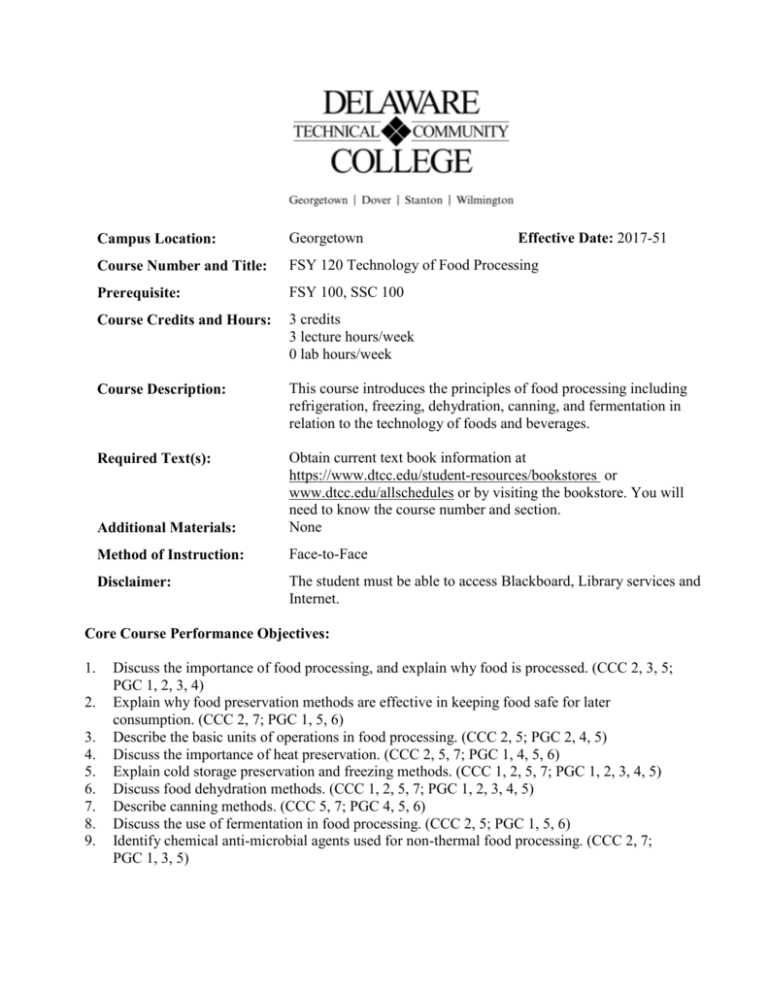
Campus Location: Georgetown Effective Date: 2017-51 Course Number and Title: FSY 120 Technology of Food Processing Prerequisite: FSY 100, SSC 100 Course Credits and Hours: 3 credits 3 lecture hours/week 0 lab hours/week Course Description: This course introduces the principles of food processing including refrigeration, freezing, dehydration, canning, and fermentation in relation to the technology of foods and beverages. Required Text(s): Additional Materials: Obtain current text book information at https://www.dtcc.edu/student-resources/bookstores or www.dtcc.edu/allschedules or by visiting the bookstore. You will need to know the course number and section. None Method of Instruction: Face-to-Face Disclaimer: The student must be able to access Blackboard, Library services and Internet. Core Course Performance Objectives: 1. 2. 3. 4. 5. 6. 7. 8. 9. Discuss the importance of food processing, and explain why food is processed. (CCC 2, 3, 5; PGC 1, 2, 3, 4) Explain why food preservation methods are effective in keeping food safe for later consumption. (CCC 2, 7; PGC 1, 5, 6) Describe the basic units of operations in food processing. (CCC 2, 5; PGC 2, 4, 5) Discuss the importance of heat preservation. (CCC 2, 5, 7; PGC 1, 4, 5, 6) Explain cold storage preservation and freezing methods. (CCC 1, 2, 5, 7; PGC 1, 2, 3, 4, 5) Discuss food dehydration methods. (CCC 1, 2, 5, 7; PGC 1, 2, 3, 4, 5) Describe canning methods. (CCC 5, 7; PGC 4, 5, 6) Discuss the use of fermentation in food processing. (CCC 2, 5; PGC 1, 5, 6) Identify chemical anti-microbial agents used for non-thermal food processing. (CCC 2, 7; PGC 1, 3, 5) See Core Curriculum Competencies (CCC) and Program Graduate Competencies (PGC) at the end of the syllabus. Course objectives are coded to the competency(cies) they develop. Measurable Performance Objectives: Upon completion of this course, the student will: 1. Discuss the importance of food processing, and explain why food is processed. 1.1 1.2 2. Explain why food preservation methods are effective in keeping food safe for later consumption. 2.1 2.2 2.3 3. Discuss the importance of basic unit operations. Examine packaging methods of foods. Describe material handling methods. Provide examples of separation methods. Describe methods of cleaning food. Describe homogenization, mixing, and pumping methods. Discuss the importance of heat preservation. 4.1 4.2 4.3 4.4 4.5 4.6 5. Define food preservation. List food preservation techniques, and provide examples of preserved foods. Identify thermal and non-thermal preservation methods. Describe the basic units of operation in food processing. 3.1 3.2 3.3 3.4 3.5 3.6 4. Name two main reasons why food is processed. List the six basic principles of food processing. Discuss the principles of thermal processing, sterilization, blanching, and pasteurization. Identify heat resistant microorganisms. Define high-temperature/short-time (HTST), and ultra-high temperature (UHT) processing. Define decimal reduction time (D value), 12D concept, and thermal death time (TDT). Discuss heat transfer, and explain the difference among conduction, convection, and radiant energy methods. Discuss time and temperature heat combinations. Explain cold storage preservation and freezing methods. 5.1 5.2 5.3 5.4 Discuss the history of cold storage preservation. Describe cooling, refrigeration, and freezing methods. Describe how cold storage affects the quality of food. Identify various methods of freezing. 6. Discuss food dehydration methods. 6.1 6.2 6.3 6.4 6.5 7. Describe canning methods. 7.1 7.2 7.3 8. Discuss the history and concept of canning food. Describe the processing methods of canning. Identify potential problems that may occur during canning. Discuss the use of fermentation in food processing. 8.1 8.2 8.3 8.4 8.5 9. Identify the purpose of food dehydration. Describe how drying affects the quality of food. List the common drying methods used in the food industry. Identify chemical changes that occur during drying. List four factors that affect drying. Describe the history of fermentation. Identify foods produced by fermentation. List the chemical reaction of fermentation. Explain how food spoilage occurs. List three methods to control fermentation. Identify chemical anti-microbial agents used for non-thermal food processing. 9.1 9.2 9.3 9.4 Explain how food additives are monitored and controlled. Define additives and identify which additives require certification and which are exempt. Define generally recognized as safe (GRAS) substances and explain their use as ingredients. Discuss the use of fat replacers/reducers and describe how they affect the quality of food. Evaluation Criteria/Policies: Students will demonstrate proficiency on all Core Course Performance Objectives at least to the 75 percent level to successfully complete the course. The grade will be determined using the College Grading System: 92 – 100 = A 83 – 91 = B 75 – 82 = C 0 – 74 = F Students should refer to the Student Handbook for information on Academic Standing Policy, Academic Honesty Policy, Student Rights and Responsibilities, and other policies relevant to their academic progress. Core Curriculum Competencies: (The competencies every graduate will develop) 1. 2. 3. 4. 5. Communicate clearly and effectively both orally and in writing. Demonstrate effective problem solving and reasoning skills. Work effectively in groups of people from diverse backgrounds. Demonstrate ethical and professional understanding and conduct. Apply appropriate information literacy skills to locate, evaluate, and use information effectively. 6. Use computer technology appropriate to the field. 7. Use scientific and mathematical reasoning appropriate to the technology. Program Graduate Competencies: (The competencies every graduate will develop specific to his/her major.) 1. Apply knowledge of the theories and principles of biology, chemistry and food microbiology. 2. Analyze food samples by common and quantitative and qualitative techniques. 3. Identify emerging technologies and ingredient innovations that have the potential to transform product and process development. 4. Analyze market trends associated with the development of foods to maintain and improve health. 5. Apply knowledge of food processing to improve the quality, efficiency, and sustainability of processing and packaging efforts. 6. Apply knowledge of best practices, risk analysis, traceability, and analytical tools in the areas of microbial and chemical food safety and defense. 7. Apply knowledge of public policy, food laws, and regulations that have national and international implications for the food industry, research, and consumer food safety. 8. Demonstrate professional behavior and communication skills.
